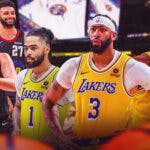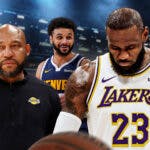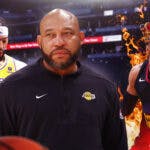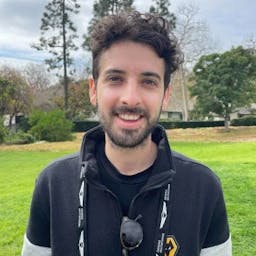The Los Angeles Lakers signed four players on the first day of 2022 free agency: Lonnie Walker IV, Damian Jones, Troy Brown Jr., and Juan Toscano-Anderson.
The Lakers used their mid-level exception ($6.5 million) on Walker IV, who spent his first four seasons with the San Antonio Spurs. Jones, a 6'11 center with a 7'4 wingspan, spent eight (effective) games with the Lakers in 2020-21. Brown Jr. offers enticing defensive upside. Toscano-Anderson is fresh off winning an NBA championship with the Golden State Warriors.
The Lakers' 2022-23 roster currently boasts 13 players: The aforementioned additions, LeBron James, Anthony Davis, Russell Westbrook, Talen Horton-Tucker, Kendrick Nunn, Stanley Johnson, Austin Reaves, Wenyen Gabriel, and recent second-round pick Max Christie (undrafted free agents Cole Swider and Scotty Pippen Jr. are on two-way contracts). We'll see whether the Lakers will round out the 15-man squad in the coming days or bide their time and work the trade wires.
Here are five notable takeaways from the Lakers' activity on June 30.
5) Klutch is still a factor
Since the tumultuous trade deadline in the wake of the LeBron-led Westbrook fiasco, the Lakers brass has been (at least optically) trying to mitigate the influence of Rich Paul and Klutch Sports over franchise operations. You wouldn't know it after Thursday, as Walker IV, Brown Jr., and Toscano-Anderson are repped by Klutch.
Each addition is defensible, and it's hard to wholly avoid Klutch considering their voluminous clientele (including AD). Maintaining a strong relationship with Paul is imperative in the modern NBA landscape. It can also help the Lakers lure players below market value.
That said, it doesn't exactly convince outsiders that the Lakers are wriggling themselves from Klutch's grasp when three clients are signed within the first two hours of a critical free agency period.
4) Their limited capital was consequential
The Lakers' financial inflexibility was on full display. Numerous appealing players — many of whom had been linked to Los Angeles or would've made sense for the MLE — ended up nabbing deals above the Lakers' pay grade:
- Malik Monk: two years, $19 million – Sacramento Kings (L.A. offered Monk the TPMLE, per ESPN).
- Isaiah Hartenstein: two years, $16 million – New York Knicks
- Gary Harris: two-year, $26 million – Orlando Magic
- Mo Bamba: two years, $21 million – Magic
- Nic Claxton: two years, $20 million – Brooklyn Nets
- Patty Mills: two years, $14.5 million – Nets
- Kyle Anderson: two years, $18 million – Minnesota Timberwolves
- Nicolas Batum: two years, $20 million – Los Angeles Clippers
- Chris Boucher: three years, $35 million – Toronto Raptors
- JaVale McGee: three years, $20 million – Dallas Mavericks
- Delon Wright: two years, $16 million – Washington Wizards
BTW: The Lakers could have offered Walker IV a two-year version of the MLE, but remain intent on keeping their books clean for 2023. Both Walker IV and Brown Jr. are former first-round picks who will aim to rebuild their value after a year under the spotlight in Los Angeles.
3) The Lakers prioritized youth, athleticism, and defense
The Lakers learned from their mistakes of last offseason, when they signed eight players over the age of 30. As the season progressed, their youngsters – Reaves, Johnson, Gabriel — proved to be their most useful non-stars.
By contrast, Los Angeles scooped Toscano-Anderson (29), Jones (27), Walker IV (24), and Brown Jr. (23) on Thursday.
At the moment, LeBron and Russ are the only members of the Lakers' 13-man roster over the age of 30
— Michael Corvo (@michaelcorvoNBA) July 1, 2022
Jones brings elite verticality. JTA is hard-nosed with an enviable motor and major ups. Brown Jr. has a 6'10 wingspan. Walker IV carries a reputation as a strong defender, though the metrics disagree. Either way, the Lakers added four motorized defensive-minded players with switchability and something to prove.
2) …But not big wings and shooting
The Lakers targeted two-way wings — preferably large fellas who could space the floor.
Walker IV is 6'4. Brown Jr. and JTA are 6'6. Not quite the RoCo/T.J. Warren/Otto Porter Jr./Young Ariza 6'8-6'9ish archetype they sought out. All three can become valuable and above-average perimeter stoppers, if they aren't already. But the Lakers still need more size and strength on the wing besides LeBron.
Meanwhile, questions remain about the “3” aspect of their games (Pelinka will surely classify each as “3-and-D” guys in his presser). Walker IV and Brown Jr. are roughly 34% career three-point shooters (Walker did hit 40.6% in 2020-21). JTA has made 36% of his attempts at low volume.
Max Christie projects well as a shooter but isn't expected to contribute much as a rookie. Jones is an efficient rim runner but not a stretch-5.
The Lakers lost arguably their two best shooters from last season: Monk and, seemingly, Carmelo Anthony. As it stands, the roster is bereft of dependable snipers. According to ESPN's Dave McMenamin, the Lakers will address their outside shooting going forward.
Understandably, the Lakers have supreme faith in their esteemed scouting department/player development pipeline. They'll hope Walker IV and Brown Jr. enjoy breakout campaigns similar to Monk last season.
1) Kyrie Irving on the way?
Admittedly, I buried the lede.
The biggest news of the day was Kevin Durant requesting a trade, which, in turn, increased the likelihood of Kyrie landing in Los Angeles.
LeBron explaining how the Lakers can land Kyrie Irving after allpic.twitter.com/KfUa91aE0H
— Michael Corvo (@michaelcorvoNBA) June 30, 2022
Durant's request automatically lowers Irving's trade value. The Nets are suddenly thinking long-term; no longer desperate to field a contender around Durant ASAP. Irving, on a $36 million expiring contract, can signal to any interested ballclub that he's bolting to the Lakers outright in 2023, placing Pelinka in pole position.
A trade based around Russ and the 2027 and 2029 first-round picks in exchange for Irving is legitimately realistic, if not probable. The Lakers — along with the rest of the NBA — will now operate at the pace of the Nets front office.
Boring stuff, I know.




